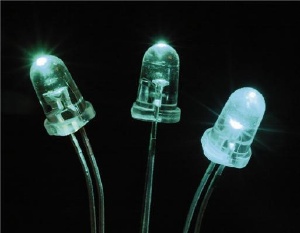Jul 2 2009
New developments in a substance which emits brilliant light could lead to a revolution in lighting for the home and office in five years, claims a leading UK materials scientist, Professor Colin Humphreys of Cambridge University. The source of the huge potential he foresees, gallium nitride (GaN), is already used for some lighting applications such as camera flashes, bicycle lights, mobile phones and interior lighting for buses, trains and planes. But making it possible to use GaN for home and office lighting is the Holy Grail. If achieved, it could reduce the typical electricity consumption for lighting of a developed country by around 75% while delivering major cuts in carbon dioxide emissions from power stations, and preserving fossil fuel reserves.
 In search of the 60 - year household light bulb - packaged green LEDs on InGaN multiple quantum well devices grown at Cambridge University
In search of the 60 - year household light bulb - packaged green LEDs on InGaN multiple quantum well devices grown at Cambridge University
'GaN LEDs have a very exciting future' says Professor Humphreys. 'In particular they are incredibly long lasting. A GaN LED can burn for 100,000hours - one hundred times longer than a conventional light bulb. In practice this means it only needs replacing after 60 years of normal household use. Also, unlike the energy-saving compact fluorescent lights now in use, GaN LEDs don't contain mercury so disposal is not such an environmental headache.'
But to unlock these benefits, important barriers need to be tackled by scientists. GaN LEDs are too expensive to manufacture for wide scale deployment in homes and workplaces. And the harsh quality of the light produced is another limiting factor. At the Cambridge Centre for Gallium Nitride where Professor Humphreys leads the research, a detailed new theory that explains the mystery of why GaN emits light so strongly has recently been developed in collaboration with Professor Phil Dawson of Manchester University. 'Such understanding is vital to improving GaN lighting's quality and efficiency' says Professor Humphreys. 'Our centre is also working on an innovative technique for growing GaN on six-inch diameter silicon wafers, rather than the sapphire wafers used to date. This could deliver a tenfold reduction in manufacturing costs and so help GaN lighting penetrate new markets'. Another of the centre's projects is investigating how GaN lighting could be made to mimic sunlight which could have important benefits for sufferers of Seasonal Affective Disorder (SAD).
'GaN lighting should start making its mark in homes and offices within about five years', predicts Professor Humphreys. 'That won't just be good news for the environment - it will also benefit consumers in terms of convenience, electricity bills and quality of life.'
Looking further ahead, the possibilities for GaN light appear wide-ranging. Currently, GaN LEDs are phosphor -coated to transform the light from blue into white. But there could be scope to remove the coating and incorporate mini LEDs, each producing a different colour, in the overall 'light bulb'. Together the mini LEDs would produce white light, but people in the home or office could alter the precise balance, for example to a bluish light, to suit their mood. 'This and other applications, for example in healthcare for detecting tumours, and water treatment for developing countries, might be achievable in 10 years', says Professor Humphreys.